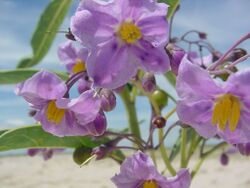Biology:Solanum glaucophyllum
| Solanum glaucophyllum | |
|---|---|

| |
| Scientific classification | |
| Kingdom: | Plantae |
| Clade: | Tracheophytes |
| Clade: | Angiosperms |
| Clade: | Eudicots |
| Clade: | Asterids |
| Order: | Solanales |
| Family: | Solanaceae |
| Genus: | Solanum |
| Species: | S. glaucophyllum
|
| Binomial name | |
| Solanum glaucophyllum Desf.
| |
| Synonyms[1] | |
|
List
| |
Solanum glaucophyllum is a species of plant in the family Solanaceae. It is known as waxyleaf nightshade.[2] It is native to Brazil, Bolivia, Argentina, Paraguay and Uruguay.
It is usually classified under the section Cyphomandropsis, within the subgenus Bassovia.
It is a rhizomatous plant with a simple stem and shortly branched, growing to 1–2 m tall or more. The leaves are simple, ovate, lanceolate, greenish-gray, and the plant produces 1–2 cm long, bluish purple flowers. The fruit is a globose berry 1–2 cm in diameter, blue-black, and features several seeds inside. It propagates vegetatively by gemmiferous roots of high regeneration capacity in water-saturated soils like edges of lakes.
Its consumption by ruminants produces an illness on them.
References
- ↑ "Solanum glaucophyllum Desf.". Board of Trustees of the Royal Botanic Gardens, Kew. 2017. http://powo.science.kew.org/taxon/urn:lsid:ipni.org:names:321717-2#synonyms.
- ↑ "Solanum glaucophyllum". Natural Resources Conservation Service PLANTS Database. USDA. https://plants.usda.gov/core/profile?symbol=SOGL3. Retrieved 17 November 2015.
Wikidata ☰ Q148619 entry
 |

